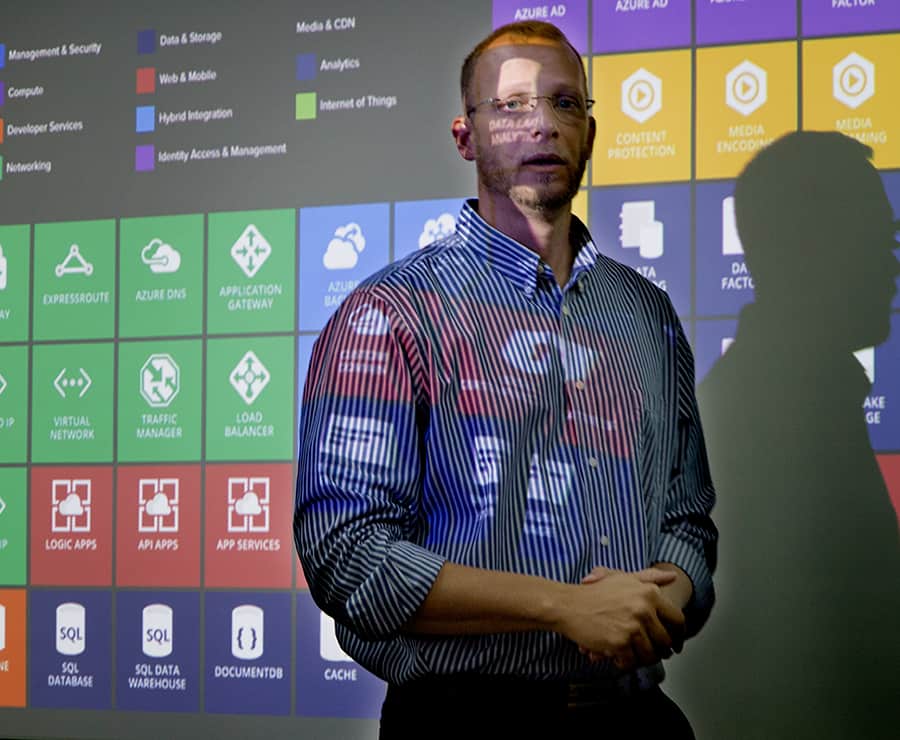
Above: Innova’s Christian Anton demonstrates Azure’s services. Photo by Mark Lyndersay
BitDepth#1144 for May 10, 2018
Last week, Inova Solutions, a Microsoft partner based in Curaçao, delivered a robust introduction to the capabilities of Azure, the Redmond company’s flagship cloud solution for business.
“There’s a real danger in thinking about new things using the frameworks of the old,” warned Heidi Alert, Inova’s Country Manager for Trinidad and Tobago.
Presenting to a small but engaged audience at Microsoft’s offices in St James, Christian Anton, Inova’s Technical Solutions Architect offered up an overview of Azure, which has evolved significantly since it was introduced in 2010.
After the fuzzy commitment of that early start in could services, which was presaged by the introduction of mercifully short lived, ‘web app’ versions of the company’s productivity software, Microsoft has doubled down and then doubled down again on Azure, turning it into a remarkable suite of enterprise class software solutions that just happens to sit on remote servers.
“Azure is your own full-service data center, on demand,” said Anton, and he wasn’t kidding.
The suite of services offered by Azure is, quite simply, insane.
Azure services provider Concurrency has created a live ‘periodic table’ of services available on Microsoft’s cloud that offers details on 68 separate offerings.
“Azure,” said Anton, “is Microsoft’s future, it’s been the biggest part of their business for the last two years and it is the future of the company.”
“For many businesses, their first foray into the cloud is with a SaaS (Software as a Service) product like Office 365.”
“But if someone says they are an expert in Azure, that’s dangerous, because you would have to be an expert in dozens of technologies, from machine learning to mobile deployment.”
“A journey to the cloud has no standard solutions.”
Anton’s presentation was thorough and clear, beginning from the basics of backup to the deeper commitment that’s necessary for disaster recovery and the restoration of data, apps and configuration profiles that are necessary to provide effective business continuity when – not if – systems fail or are destroyed.
Anton identified seven tiers of backup capacity, from tier two, which is the simplest architecture for backup and recovery to tier seven, where there is immediate redundancy and close to zero data loss.
At the highest levels of tier seven, a business doesn’t even notice catastrophic data loss because there is complete redundancy and immediate switch over of mission critical services.
Azure supports this halcyon goal for data protection through software that can implement this level of redundancy in a strictly local hardware or by switching over to a cloud based version of the installation.
“This level,” warned Anton, “is VERY expensive.”
For IT departments, it means not just the cost of maintaining a full duplicate of hardware and software and that means maintaining two full server rooms.
The key delimiters in backup planning are RTO, the Recovery Time Objective, how long it takes to recover data that’s been lost from backup systems and RPO, the Recovery Point Objective, the point at which the last backup was run.
Most local companies, he said, function between tiers three and four, which allows for mid-level cost, reasonably quick restoration of data and the loss of only a few hours of the most recent data moving through the organisation.
In just eight years, Azure has become one of the best and most pervasive secrets of modern computing. It has grown with stunning speed and managed to track closely with its most aggressive competitor in the space, Amazon Web Services, racking up an admirable list of who’s who names as customers, including Dell, Fujitsu and Apple.



It’s sad that I have to point out that there are other options, that Azure is only one, and that it puts one soundly in the hands of Microsoft who wants you right there.